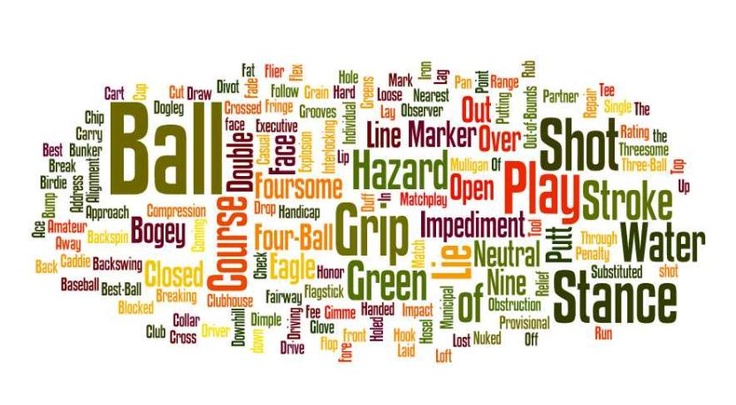Golf has a unique and sometimes bewildering language, but the following guide explains the most common terms you’ll hear out on the course.
Ace: A hole-in-one.
Albatross: Completing a hole three strokes under par i.e. 2 on a par 5.
Approach: A shot to the green intended to finish as close as possible to the pin.
Ball marker: A small, flat item similar to a coin that is used to mark the position of a ball on the green.
Birdie: Completing a hole one stroke under par i.e. 3 on a par 4.
Bogey: Completing a hole one stroke over par i.e. 5 on a par 4.
Bump-and-run: A chip shot deliberately kept low to get the ball rolling along the ground.
Bunker: The sandpits that reside all over a golf course. If your ball ends up in one, a one stroke penalty applies if your club makes contact with the surface prior to playing your shot.
Break: The undulation that needs to be taken into account when putting on a green.
Caddie: A person employed to carry a player's bag for the round who also offers advice on factors such as distances, club choice and analsing the break on the greens.
Carry: The horizontal distance a golf ball travels while airborne.
Chip: A short shot that is usually played in the vicinity of the green.
Chopper: A golfer of limited ability who tends to take deep and inconsistent divots.
Cup: The hole’s subterranean sleeve that holds the flag stick in place.
Divot: A chunk of turf that is dug up in the process of striking the golf ball.
Dogleg: A kink or bend in a fairway.
Draw: A shot that gently curves from right-to-left (RH golfer).
Drive: Hitting the ball into play off the tee at the start of a hole.
Driver: The club with the biggest head that hits the ball the farthest. Gets used off the tee on the majority of holes.
Drop: Releasing a ball by hand from shoulder height to resume play after finding trouble, incurring a one stroke penalty.
Eagle: Completing a hole two strokes under par i.e. 3 on a par 5.
Fade: A shot that gently curves from left-to-right (RH golfer).
Fairway: The track of shortly cut grass that extends from the tee to the fringe/green.
Fat: Hitting the turf behind the ball prior to impact, with a resulting reduction in shot distance.
Flier: A shot that unintentionally comes out with minimal spin and subsequently goes further than anticipated.
Flusher: An elite ball striker.
Free drop: Releasing a ball by hand from shoulder height to resume play, with no penalty incurred.
Fore: The term shouted to warn fellow golfers of impending danger, usually from a ball heading in their vicinity.
Fringe: The tightly mown grass between the fairway and the green.
Gimme: A putt deemed unmissable.
Green: The firm, tightly mown surface where the hole is located.
Hacker: A golfer who consistently plays very poorly.
Handicap: A number which indicates how many strokes to either add or subtract from your score at the end of a round, which is calculated according to your previous performances. A handicap is meant to equalise golfers of differing abilities.
Hazard: A bunker, or an area of the course such as a lake, creek, ocean or waste area defined by red stakes or lines. Like bunkers, a one stroke penalty applies if you ground your club before playing your shot.
Honor: The right to tee off first in your group after having the best score on the previous hole.
Hook: A shot that curves severely from right-to-left (RH golfer).
Irons: The metal clubs that are sequentially numbered to correspond with their lofts, each of which will hit the ball a certain height and distance.
Knock down: A shot with reduced spin that is deliberately kept low by taking less than a full swing.
Lag: A putt that is played to finish around the hole, but isn’t necessarily intended to be holed.
Lay-up: A shot played primarily to improve the position of the next shot, or a shot played deliberately short to reduce the risk of finding trouble.
Lip: The turf that protrudes around the edge of a bunker.
Par: The expected number of strokes it should take to get your ball in the hole (e.g. par 4), or the expected total score around the entire 18 holes (e.g. par 72).
Pitch: A usually high-spinning shot that is played within 80-40m from the hole.
Pitch mark: The indentation that is left after a ball strikes the green. Needs to be repaired with a pitch mark repair tool.
Pin: The flag stick that indicates where the hole is located.
Pin high: When a ball travels the correct distance to the pin but finishes left or right of it.
Provisional: A second ball that is put into play when there is doubt about whether the first ball will be found. Stroke penalties may apply.
Pull: A shot that starts and stays left of the target (RH golfer).
Push: A shot that starts and stays right of the target (RH golfer).
Putter: The flat-faced club that rolls the ball smoothly to the hole on the greens.
Rough: The thick and occasionally tall grass that borders the edge of the fairway.
Shank: When the ball strikes the hosel of the club, rather than the club face, resulting in a shot that flies dramatically sideways.
Slice: A shot that curves severely from left-to-right (RH golfer).
Stroke: An attempt at hitting the ball, whether successful or not, which is then tallied after each hole to record the score. Also refers to the attributes of a golfer’s action when putting.
Tee: The peg you push into the ground to sit your ball on. Also the area from which you commence playing a hole from.
Thin: A strike that catches the ball close to the equator, resulting in a low ball trajectory and minimal spin.
Up and down: Chipping onto the green and sinking the resulting putt.
Wedge: The shortest irons in a set that fly the highest and stop the quickest. Are also used around the greens for chip shots and bunker shots.
Windy: An attempted stroke that doesn’t make contact with the ball but still counts as one.
Yips: Consistent, inaccurate putting or chipping, usually from very short distances.




